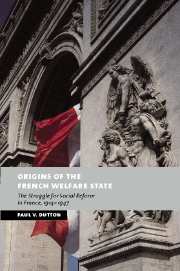Book contents
- Frontmatter
- Contents
- List of figures
- List of tables
- Acknowledgments
- List of abbreviations
- Introduction
- 1 An industrial model of family welfare
- 2 A mutual model for social insurance
- 3 Battle for control of social welfare: workers versus employers
- 4 Parliament acts
- 5 Challenges from city and countryside, 1930–1939
- 6 Retrenchment and reform, 1939–1947
- Conclusion
- Bibliography
- Index
5 - Challenges from city and countryside, 1930–1939
Published online by Cambridge University Press: 13 July 2009
- Frontmatter
- Contents
- List of figures
- List of tables
- Acknowledgments
- List of abbreviations
- Introduction
- 1 An industrial model of family welfare
- 2 A mutual model for social insurance
- 3 Battle for control of social welfare: workers versus employers
- 4 Parliament acts
- 5 Challenges from city and countryside, 1930–1939
- 6 Retrenchment and reform, 1939–1947
- Conclusion
- Bibliography
- Index
Summary
The Depression and accompanying political turmoil greatly influenced the course of social reform in France. The country suffered nearly a million and a half unemployed at the height of the economic crisis. Fascist leagues proliferated and nearly toppled the Third Republic in rioting on 6 February 1934. The rightist threat and a rapprochement between France and the Soviet Union led to the reunification of the CGT and CGTU in 1935. Fence mending by union leaders paralleled creation of a Popular Front by parliamentary socialists and communists. Membership in the unified CGT increased dramatically after reunification, growing from 1 million in 1935 to 5.3 million in 1936. In the metals sector, CGT membership grew from 50,000 in February 1936 to 775,000 one year later. The CFTC also witnessed unprecedented growth, ballooning from 150,000 in 1935 to over half a million members and 1,750 syndicates by 1937.
The family welfare system approached collapse during these stressful years. Artisanal and small commercial employers persisted in their subversion of the 1932 law through the creation of professional caisses de compensation that enrolled employers in sectors where child dependency ratios were extraordinarily low. This, of course, meant rising premiums for interprofessional caisses whose membership became dominated by firms where workers had above average numbers of dependent children. Conflict between employers over burden sharing would remain a burning ulcer for family welfare until 1945. A particularly strident piece of Popular Front legislation further challenged the industrial model of family welfare.
- Type
- Chapter
- Information
- Origins of the French Welfare StateThe Struggle for Social Reform in France, 1914–1947, pp. 137 - 183Publisher: Cambridge University PressPrint publication year: 2002

